#Quaternions
Explore tagged Tumblr posts
Note
Wait until he finds out about imaginary numbers.
Or quaternions.


Flowey: Ughhhh!

Flowey: I'm an expert in everything including math, but it just slows down everything unecessarily! Time is wasted with scientific computing and measuring ingredients.
That's why I havent actually cooked for the kid yet.

Flowey: That and... This is a really bad spot to make a cooking fire. But I don't want to move.
...
What's quaternions?
#undertale#flowey#ask blog#ask flowey#art#ask undertale#small artist#undertale fanart#undertale art#paper art#flowey undertale#math#quaternions#imaginary numbers#Eandcheckmark#thecriticalhitof87
21 notes
·
View notes
Text
What if we had three square roots of -1? Haha, ijk.
241 notes
·
View notes
Text
youtube
I love you quaternions, I love you 3Blue1Brown's labors of love
7 notes
·
View notes
Text



I realized I hadn't shared this here yet! Here's my 3D printed Quaternion Julia Set! See I first learned of these things reading about it from a pretty well known graphics programmer Inigo Quilez. Theirs are a lot prettier! But yeah, if you're familiar with Julia Sets and the Mandelbrot set already, this is basically that but we use 4D complex numbers called quaternions instead of the regular old complex numbers.

The original shaders I used to render them were unity CG/HLSL implementations, but this particular one is from a GLSL implementation over on my shadertoy you can find here: https://www.shadertoy.com/view/tdt3W8 It isn't exactly the same one that I've printed here (I've long lost the exact seed) but it is reasonably close. The way I printed it was I stole some marching cube code for blender and just plugged in the SDF function derived by Inigo Quilez, tweaked the values and eventually got a mesh I can print!

This uh, isn't the one I used lol. It did take a few tries to get one that was both visually interesting and also printable. In fact i wasn't even using the marching cube algorithm at first. I was using Poisson Surface Reconstruction with a python script that casted points to form a point cloud. Basically I was attempting to create a mesh like you would with photogrammetry, just with an abstract object rather than an actual thing or place.
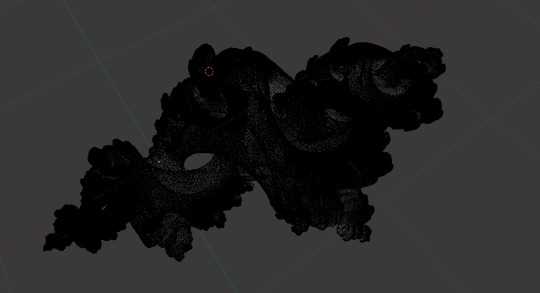
The results were, well not good lol.
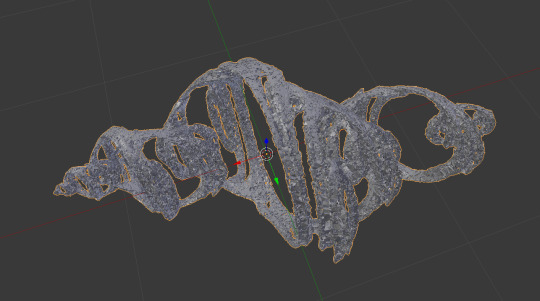
*Continues digging through box* I know its around here some where, I should have the one that works. Okay this still isnt it but this one is using the same method, I just wanted to use this for a vrchat world instead of using it for 3D printing. It gets the point across lol
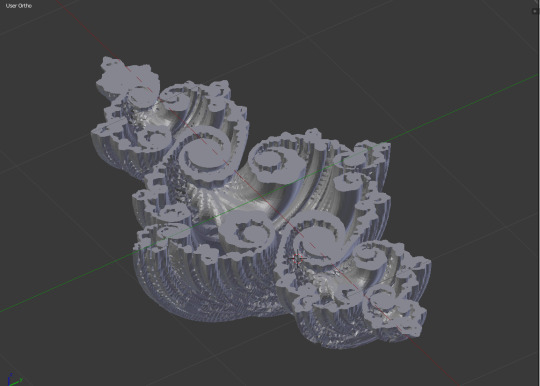
But yeah. 3D printing is really cool if you're into a bit of math
#julia set#fractal#quaternion#quaternions#3d printing#math#mathematics#blender3D#mathblr#progblr#codeblr#mandelbrot#programming#coding
125 notes
·
View notes
Text
"The Peculiar Math That Could Underlie the Laws of Nature", Natalie Wolchover, QUANTA MAGAZINE
#math#Cohl Furey#Quanta Magazine#quaternions#laws of nature#quantum physics#quantum mechanics#University of Cambridge
4 notes
·
View notes
Text
Hey math Tumblr, how normal is the experience of finally interacting with maths education that actually explains why things are, and then being irrationally angry, because "if you'd just told me that 20 years ago I would have understood!"?
Like, I am 35 and no one every explained that complex numbers are just a perpendicular axis to the real number line. That one piece of information let me understand imaginary numbers and no one told me!
I was randomly watching a video on quaternions, and I'm listening to them explain why it works and I'm nodding and following. And then they show the fucking equation. I'm sitting there in shock, because I know these equations. I learned how to do fucking quaternions and no one even told me that was what I was learning much less how or why it worked; just here's an equation memorize it and use it for these questions. I'm furious.
2 notes
·
View notes
Text
1 note
·
View note
Text
Ok well let me give you a small taste and teach you something I learned recently (that would maybe come towards the end of the course). I'm usually not a big geometry fan, but the connection here is really nice, so sit down and let me tell you about quaternion algebras and conics.
Prerequisites: Linear Algebra, some basic knowledge of field extensions, (recommended) Galois Theory
I have yet to find a good way to type in latex with formatting on tumblr, and I started this blog post on overleaf, so unfortunately I am going to be screenshotting a pdf for you. The full pdf is for download at the end of the post. Enjoy
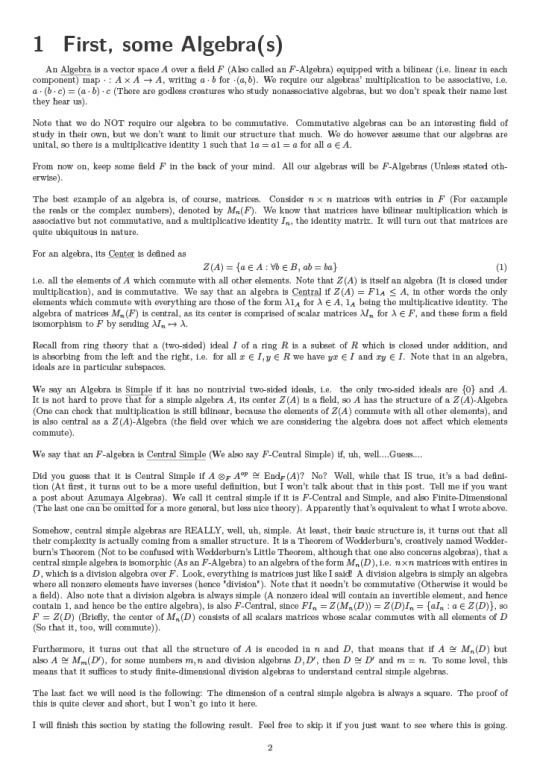
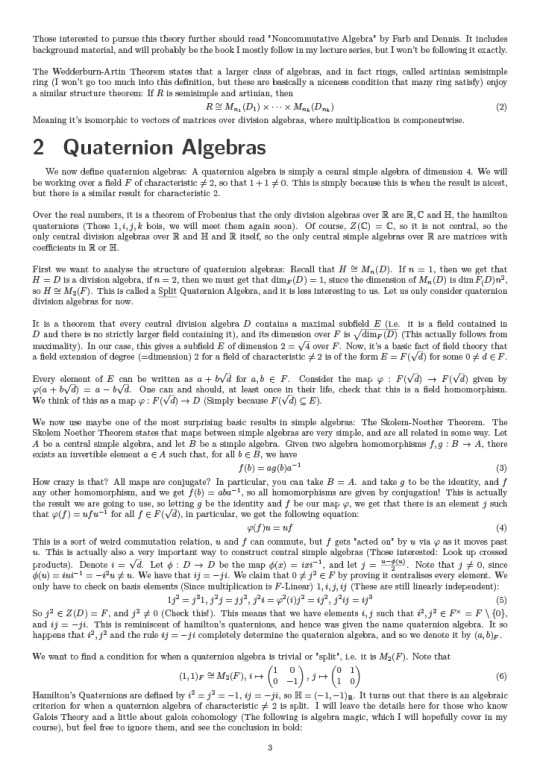
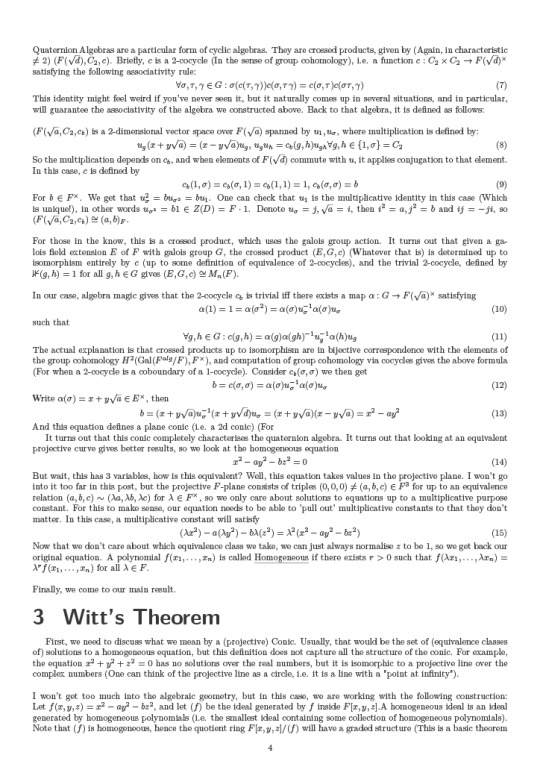
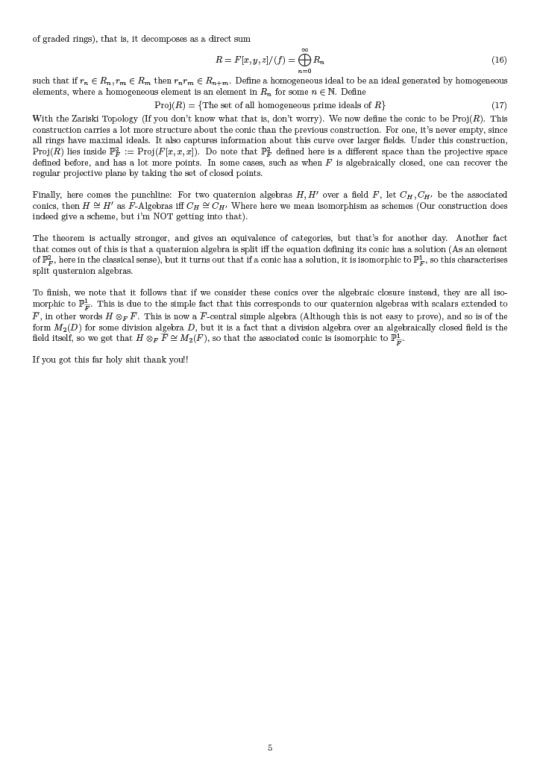
And here is the link to download the pdf:
If this link ever expires and someone wants it please let me know!
Would people be interested in a video course on noncommutative algebra? The prerequisite knowledge would be linear algebra, basic group module theory and in the end some knowledge of Galois theory. Topics I might teach would include: Jacobson Radical Theory Central Simple Algebras Wedderburn-Artin and Wedderburn-Mal'tsev The Double Centraliser Theorem Noether-Skolem Theorem Brauer group Theory Crossed Products and Galois Theory Group Cohomology, briefly, and connection with the Brauer Group Further topics to be decided (Maybe Morita Theory, or more Brauer Theory).
161 notes
·
View notes
Text
to this day i still think it’s so heartbreaking that so(3) is not commutative
#is there a commutative way to describe 3d rotations#smells like the answer should involve quaternions but i’m not sure#if you’re confused look up ‘3d rotation group’ on wikipedia
29 notes
·
View notes
Text

52 notes
·
View notes
Text

#fractal#fractal art#digital art#animation#quaternion Newton-Raphson algorithm#look-up table#ImageJ#original content
15 notes
·
View notes
Text
What you want are non communitive number systems!
Off the top of my head, you can create number systems based on "actions" and have each number be a type of thing you can do (like, say, a series of turns on a rubiks cube) and multiplication gives you another action, which is just, do one thing then the other.
You can imagine that, even with the rubix cube example, a•b ("doing" a move b then "doing" a move a) isnt necessarily the same as b•a ("doing" a move a then "doing", a move b) and there might be reasons you would want to lable some of thease numbers as 1 or 2.
i know the "move" of not doing a move at all usually is called 1, because you get a nice thing where a•1=a, or "doing nothing, then doing something" is the same as "just doing the thing", and similarly 1•a=a
...in this case, no matter what you pick to call 2, 1•2=2=2•1, but you can imagine some reasonable choice of 1 and 2 exists where that doesnt work.
Quaternions are a famous one, where each number corresponds to a rotation and scaling in 3d space.
(its actually like. a 4d object n stuff but it doesn't really matter, i. dont know any great resources for this, wikipedia might be okay? but you can probably keyword "quaternions" and get somewhere)
Its an extension of the complex numbers, where each number is a rotation and scaling in 2d space!
(think about why i might have not been able to use the complex numbers as a non communitive number system, just based off the rotations thing)
And theres just lots of ways besides this im sure. Groups are what we call number systems that are not necessarily communitive, but are necessary associative (a(bc)=(ab)c) if you want to learn more.
Okay math side of Tumblr I need help
So I was reading Broca's Brain by Carl Sagan yesterday, and there's this point where Sagan lists off a few bizarre scientific facts as examples of how true science is often more interesting and whimsical than anything a hack pseudoscientist could make up.
One of these facts was that there's a logically sound arithmetic in which 2 times 1 is not equal to 1 times 2. This piqued my interest, so I took to Firefox and Wikipedia to figure out more, but I searched up a few things and couldn't find anything helpful.
So does anyone here know what he's talking about and how that works?
#mathblr#sorry for the long reply... you activated one of my trap cards (displaying curiosity about math)#groups#communitivity#quaternions#rubix cube#rotations#addition
12 notes
·
View notes
Text
hey does anyone wanna do this spacecraft attitude dynamics problem set for me. if i have to write any more direction cosine matrices im going to implode
#it's not even that it's /hard/ it's just time consuming as FUCK to write out alllll these vector bases and then relate them to each other#and then derive a direction cosine matrix or quaternion from THAT and then do it AGAIN around some fuckinggg AXIS OF ROTAION
9 notes
·
View notes
Text
All numbers are imaginary. Some are useful.
So, @lipshits-continuous (I like your blog very much!) was bringing to my attention someone who was, let's say, a little frustrated about having to learn "imaginary numbers". You know. They're not even real.
I don't want to write about that person specifically, I don't know them at all.
But.
My siblings in crisis.
There are no "real" numbers in this world. The act of counting is already an abstraction. If you have an apple and a pear, then counting them as two pieces of fruit is an act of forgetting all the properties that distinguish them and remembering only those that unite them. Same goes for two apples of course.
So the number 2 is already entirely imaginary. Made up. Nonsense.
This gets worse very quickly, by the way. You can't have negative apples! Sure, you can have positive fractions of apples, but I can assure you: Two halves of an apple do rarely make one apple, except when they are the two halves of the same apple. And even then: Having them cut up makes it impossible to rejoin them. Think about that.
Now you know where this is going, because let's talk about the so-called ""real"" numbers. Nasty little things. Have a look at the irrational numbers. First, there are comparatively tame irrationals: Algebraic numbers. These arise as roots of integer polynomials. You know, like our favorite, the square root of 2, the positive zero of X^2 - 2.
Did you know that the Pythagoreans believed that everything was in integer relation to each other. (For example: the lengths of a rectangular triangle could be 3-4-5, meanging one cathetus is 4/5, the other 3/5 the length of the hypotenuse.) And that when someone found out that sqrt(2) was indeed not in integer relation to, say, 1, they had him murdered? That didn't change the fact that they were wrong though. (This story is not true, of course, like all good stories. You could say: it is imaginary, but nonetheless an interesting tale to tell!)
And now, the non-algebraic, so called transcendent numbers. Like pi. We know (the abstract concept of) pi well enough to calculate the circumference of the observable universe up to the accuracy of a neutrino (or so they say, I'm not a physicist). We don't have to know it any better. We could quit at however many digits we know and that would be pi. Perfectly rational. Because if we are looking for """real""" numbers only, why should we ever even concern ourself with those nasty things?
Did you know that transcendent numbers make the vast majority of real line? Of course you do! Rationals are countable, integer polynomials are countable and thus are their roots. The real line is famously uncountable, so must be the transcendent numbers.
So. Our so called """"real"""" numbers are mostly non-precisely calculable numbers. (Arbitrarily precise, but not precise.)
Do you know what kind of numbers are used in electrical engineering? Me neither because I'm not an electrical engineer. That's right, complex numbers! Actual engineers have to actually work with the actually imaginary square roots of negative one.
Maybe Numbers aren't a thing of this world.
Maybe Abstraction is a thing of our worldview.
And maybe we can learn to cherish abstract math the way we learn to cherish abstract art: Not always a true representation of reality, but a thing of interest and beauty in itself.
#I may have made up the term#my siblings in crisis#but I like it#anyway#this got a bit ranty#i apologize#also#I believe#they use quaternions in computer simulations#to calculate rotations#but I don't know much about that
67 notes
·
View notes
Text
fuck with me
13 notes
·
View notes
Text

New interview dropped!
I interviewed Maria of Quaternion Creations about her mythology and folk-based cross stitch patterns and her book release, The Emerging Queendom! How do you pronounce Quaternion?
https://badstitch.substack.com/p/interview-with-quaternion-creations
#cross stitch#cross stitch pattern#stitchcraft#broderie#fiber arts#crossstitch#xstitch#quaternion creations#cross stitch community#cross stitch blog#mythology cross stitch#the emerging queendom#cross stitch book#cross stitch culture
6 notes
·
View notes